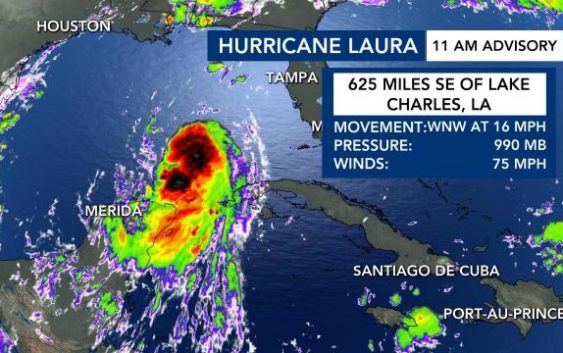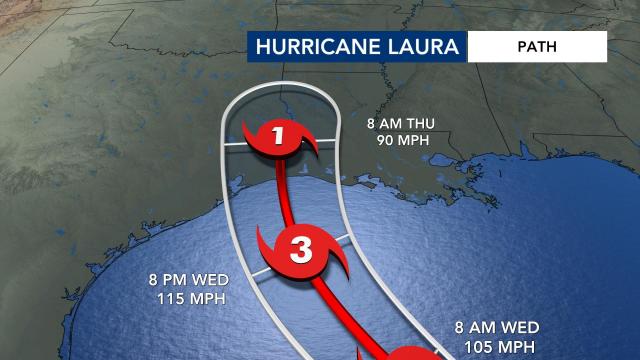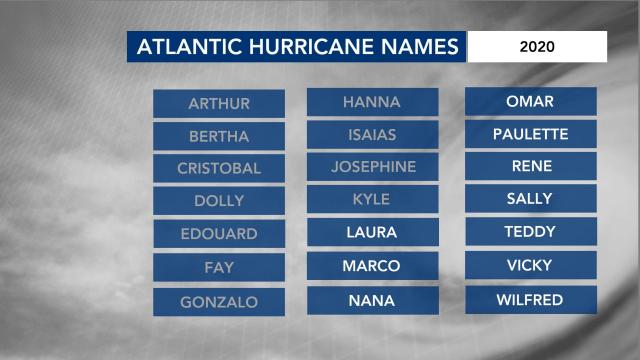- McDowell County wildfire spreads to 500 acres, evacuation orders in place
- Evacuations in Caldwell County due to wildfire
- Northwest Houston 'ghost neighborhood' caused by repeated flooding to become latest detention basin
- NHL playoffs: Hurricanes open playoffs Easter Sunday afternoon vs. Devils
- 2 wildfires spreading in rugged terrain in western North Carolina
Hurricane Laura now Cat. 2, 'life-threatening storm surge' forecast for Gulf coast

Laura strengthened into a Cat. 2 hurricane Wednesday and is expected to make landfall along the Louisiana or Texas coast by Thursday morning, as a Cat. 3 storm.
Hurricane Laura intensified overnight with winds reaching 105 miles per hour. It if develops into Cat. 3 as expected, it will be the first major hurricane of the season. The storm is forecast to make landfall overnight Wednesday or early Thursday morning with 120 mph winds.
The storm will bring life-threatening storm surge, extreme winds and flooding to the Gulf coast. WRAL meteorologist Elizabeth Gardner said the latest projections from the National Hurricane Center show Laura making landfall halfway between New Orleans and Houston somewhere along the Texas-Louisiana line.
Gardner said 4 to 8 inches of rain are likely, with 12 inches possible. The main danger, though, will be an estimated storm surge of 9 to 13 feet.
“In Louisiana, so much of that coast is at sea level – it’s flat – so it’s going to be devastating for them,” Gardner said.
Communities along the Gulf Coast in Louisiana and Texas had been on alert for a “one-two punch” of back-to-back hurricanes that meteorologists had warned might pummel them this week, but the first system to arrive, Tropical Storm Marco, significantly weakened before making landfall Monday evening. Still, a lone Category 3 could cause major damage.
Mandatory evacuations have already begun throughout portions of Louisiana and Texas to prepare for Laura’s potential landfall.
The areas within the storm’s path that have issued mandatory evacuation orders include Port Arthur, Texas, which has the nation’s largest oil refinery, and Cameron Parish, Louisiana, just across the state line. Oil and gas companies have also evacuated workers from offshore production platforms in the Gulf of Mexico.
North Carolina won’t be impacted by Laura apart from some rain coming our way next weekend, she said.
Why Laura is gaining strength over the Gulf
Water temperatures in the Gulf of Mexico are warm, with temperatures in the mid-80s, which will likely cause Laura to strengthen as it gets closer to the U.S.
“Warm sea surface temperatures really help these storms fuel and intensify,” WRAL Peta Sheerwood said.
This year’s Atlantic hurricane season has been busy, with record-setting storms. Tropical Storm Marco was the earliest named M storm in recorded history, according to WRAL meteorologist Mike Maze.
Gerry Bell, lead hurricane season forecaster with the Climate Prediction Center of the National Oceanic and Atmospheric Administration, said there could be 19 to 25 named storms — those with sustained winds above 38 mph, or 61 kph — before the season ends Nov. 30.
Of those, seven to 11 could be hurricanes, with sustained winds of 74 mph or higher, including three to six major ones.
If all the names on the list of 2020 storm names are used before hurricane season ends, meteorologists will use Greek letters to refer to the storms.
Laura is the 12th named storm of the 2020 season, and Marco the 13th, though Marco reached the U.S. mainland ahead of Laura.


